Key takeaways
- Sustainable sourcing in restaurants emphasizes eco-friendly practices, supporting local farmers, and reducing environmental impact.
- Restaurants like Plume prioritize transparency about ingredient origins, enhancing the dining experience through meaningful connections.
- Adapting menus to seasonal produce not only reduces waste but also elevates food quality and flavor.
- Engaging with restaurant staff can reveal their commitment to sustainability and enrich the overall dining experience.
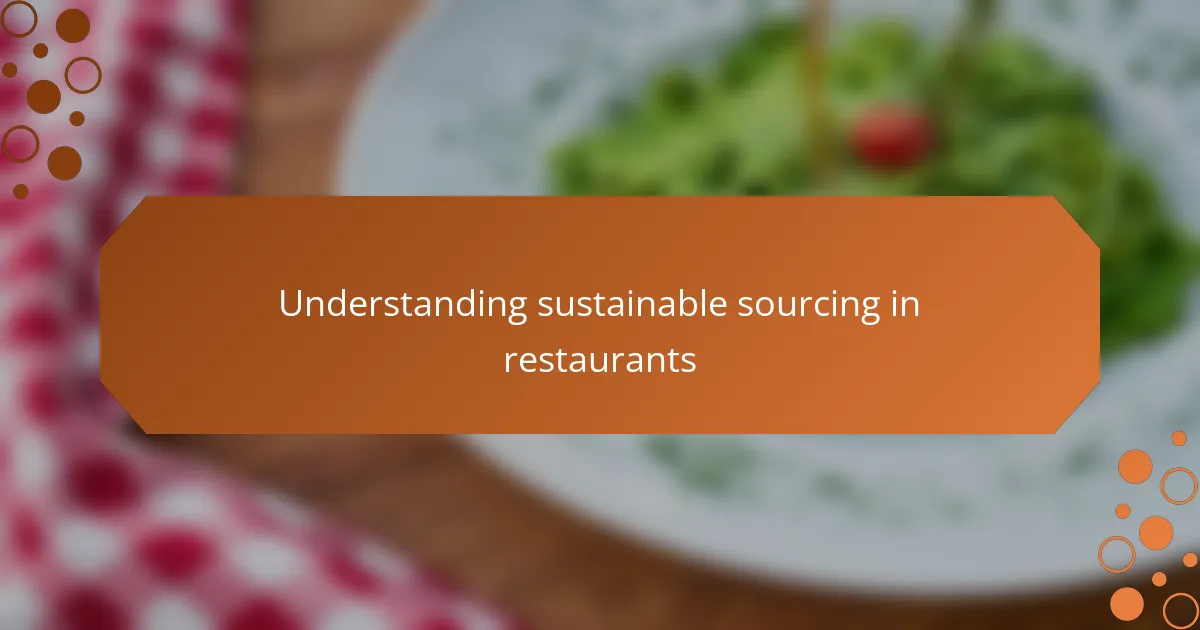
Understanding sustainable sourcing in restaurants
Sustainable sourcing in restaurants means choosing ingredients that are good for the environment, the community, and the future. It’s not just about where food comes from but also how it’s grown, harvested, and transported. Have you ever wondered if the fish on your plate was caught responsibly or if the veggies were grown locally to reduce carbon footprints?
From my experience dining in Washington DC, I’ve noticed that restaurants committed to sustainable sourcing often tell a story with their menu. It feels more meaningful knowing that the ingredients support local farmers or avoid harmful practices. This connection adds a deeper flavor, not just to the food but to the whole dining experience.
Sustainable sourcing challenges restaurants to think beyond cost and convenience. It’s a commitment that requires care, transparency, and sometimes sacrifice. Yet, the impact on preserving natural resources and supporting ethical producers makes me believe it’s a responsibility every restaurant should embrace. Wouldn’t you want to enjoy a meal knowing it contributes to a better planet?
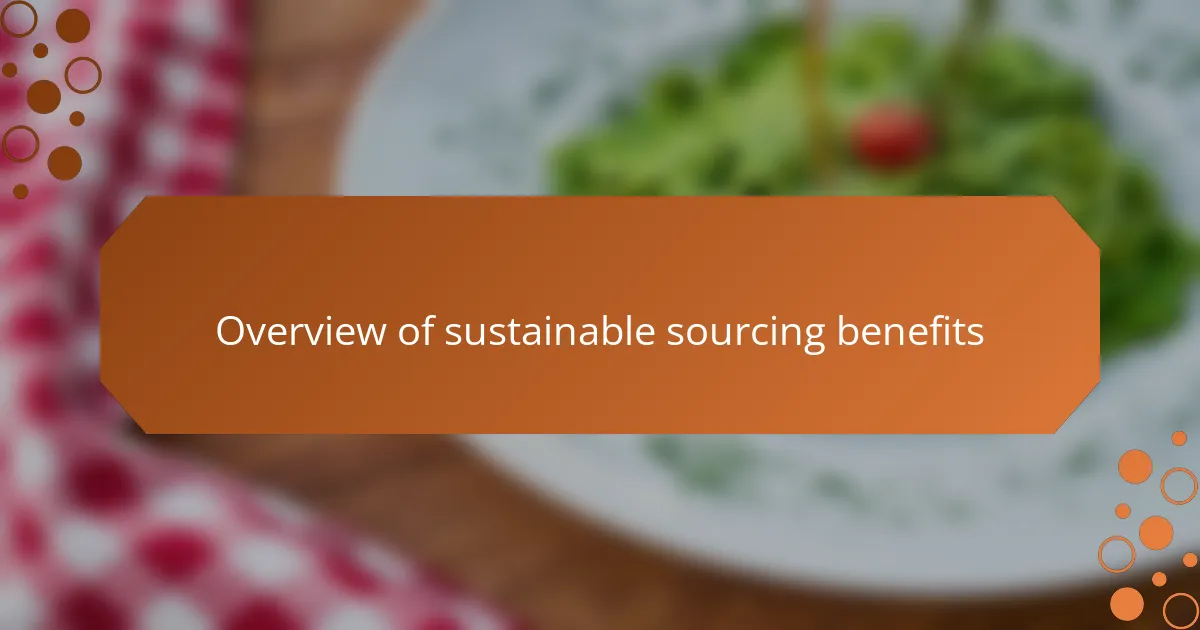
Overview of sustainable sourcing benefits
When I first learned about the benefits of sustainable sourcing, what struck me most was how it supports local communities. Knowing that my meal helps small farmers and fishers thrive makes the dining experience feel more connected and genuine. Have you ever felt that deeper satisfaction from eating something grown just a few miles away?
Another benefit that really resonated with me is the positive environmental impact. Restaurants that choose sustainably sourced ingredients are actively reducing waste, lowering carbon emissions, and protecting ecosystems. It’s comforting to think that the choices behind the scenes can make such a big difference for our planet’s future.
Beyond the planet and the people, sustainable sourcing also elevates food quality. I’ve noticed that dishes made with care and respect for the source often taste fresher and more vibrant. Doesn’t it make sense that ingredients nurtured responsibly would bring out the best flavors on your plate?
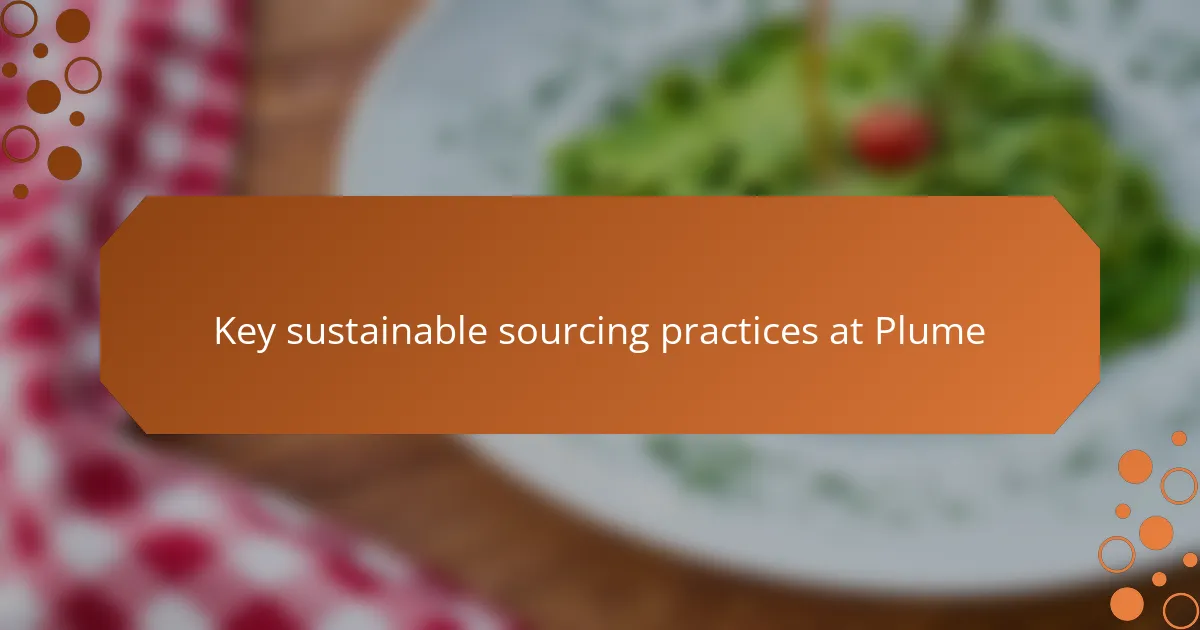
Key sustainable sourcing practices at Plume
One of the standout sustainable sourcing practices at Plume is their commitment to working exclusively with local farmers and producers. I remember asking my server about where the vegetables came from, and hearing about nearby farms that use organic methods really deepened my appreciation for the meal. It’s clear that Plume values relationships that prioritize quality and environmental care over convenience.
Another practice I found impressive is how Plume ensures seafood is responsibly caught, avoiding any species that are overfished or harvested in harmful ways. This attention to detail reassured me that every bite respects ocean ecosystems, something I don’t often see highlighted so transparently in city restaurants. Have you ever thought about the journey your seafood took before it hit your plate?
What really struck me was Plume’s focus on seasonality, meaning they adapt their menu based on what’s best and freshest throughout the year. This not only reduces waste but celebrates nature’s rhythms in a way that feels thoughtful and alive. It made me wonder—how often do we get to savor food that’s truly in harmony with the environment around us?
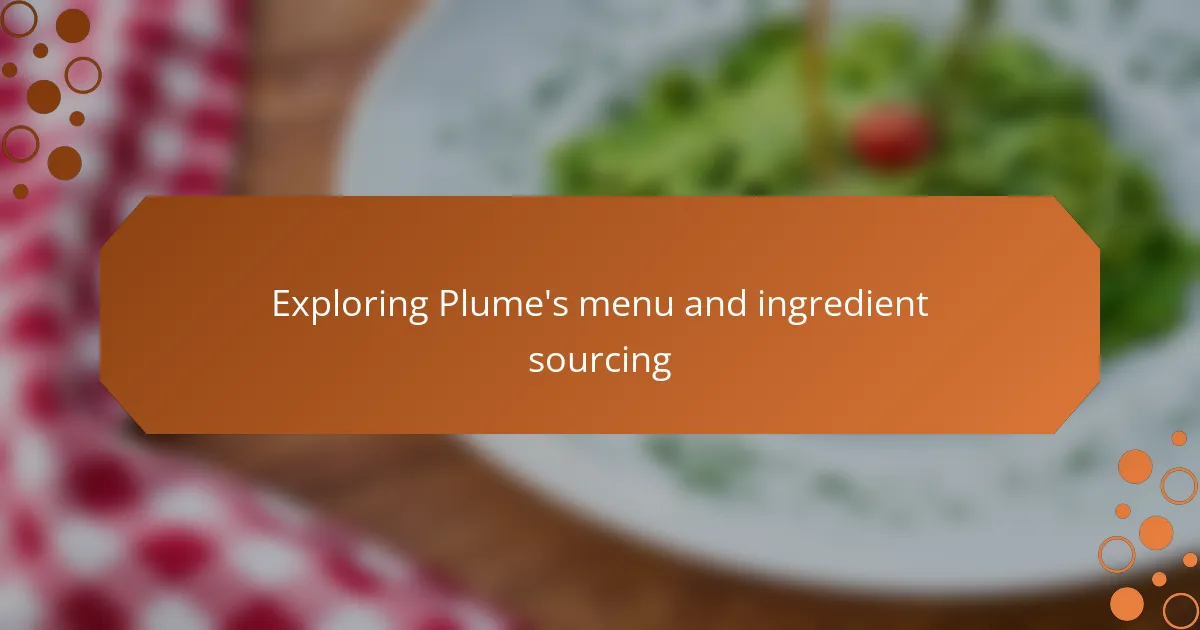
Exploring Plume’s menu and ingredient sourcing
When I first sat down with Plume’s menu, I was struck by how it felt like a curated story of the region’s bounty. Each dish highlighted ingredients that seemed thoughtfully chosen—not just for taste but for their origin. Knowing the menu changes with the seasons made me appreciate how much effort goes into aligning food choices with sustainability.
What truly caught my attention was the transparency about where ingredients come from. I asked about the sources behind a simple beet salad and was delighted to learn it featured produce from a farm just outside of DC that uses no pesticides. That kind of detail made the meal feel more personal and ethical, as if the chefs are inviting diners into their sustainable sourcing journey.
Have you ever noticed how menu descriptions can either feel generic or tell a meaningful story? At Plume, each item hinted at careful stewardship—local grains, pasture-raised meats, and responsibly harvested seafood. This approach made me realize that exploring the menu here is also an exploration of Washington DC’s thriving community of sustainable producers.
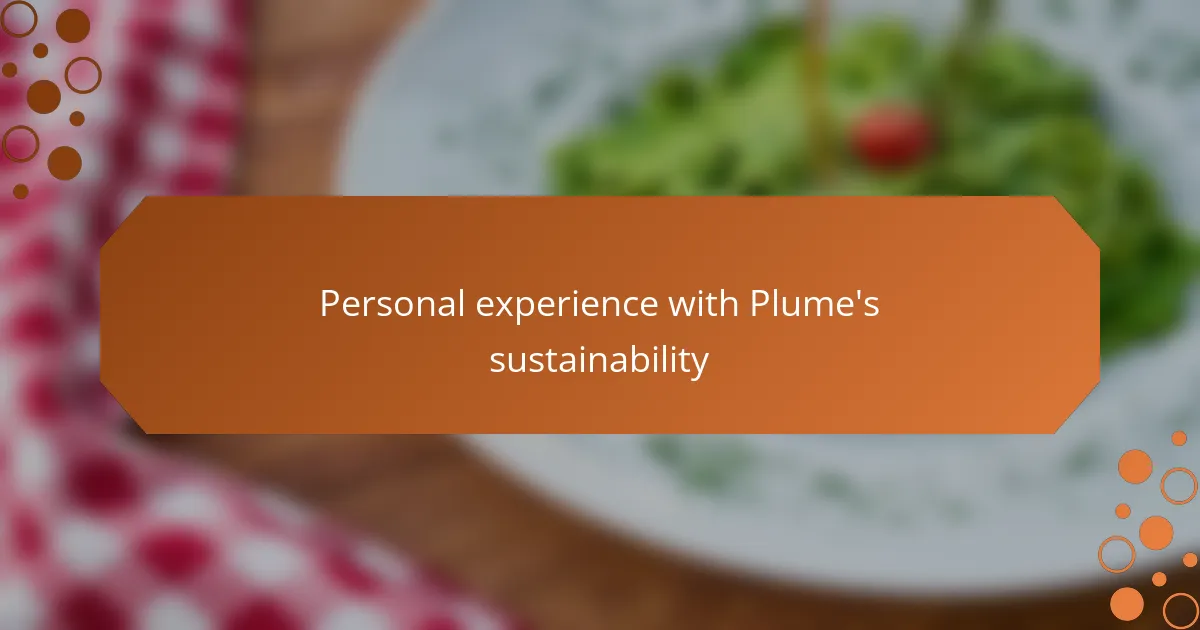
Personal experience with Plume’s sustainability
Dining at Plume was a real eye-opener for me when it comes to sustainability in restaurants. I remember feeling a genuine connection as my server explained how every ingredient on my plate was thoughtfully sourced with the environment and community in mind. It made me realize that sustainability isn’t just a buzzword here—it’s part of their DNA.
What truly touched me was tasting dishes that celebrated seasonal produce and local seafood, knowing they came from farms and fisheries I could almost picture. Have you ever experienced a meal that felt so in tune with nature’s cycles? That day at Plume, it felt like more than eating—it was participating in something meaningful.
I also appreciated how open Plume was about their sourcing choices. When I asked questions, the staff didn’t just give vague answers—they shared stories about farmers, conservation efforts, and careful harvesting techniques. It made me feel like I was part of a community that cares deeply about the planet, which honestly changed how I think about dining out in DC.
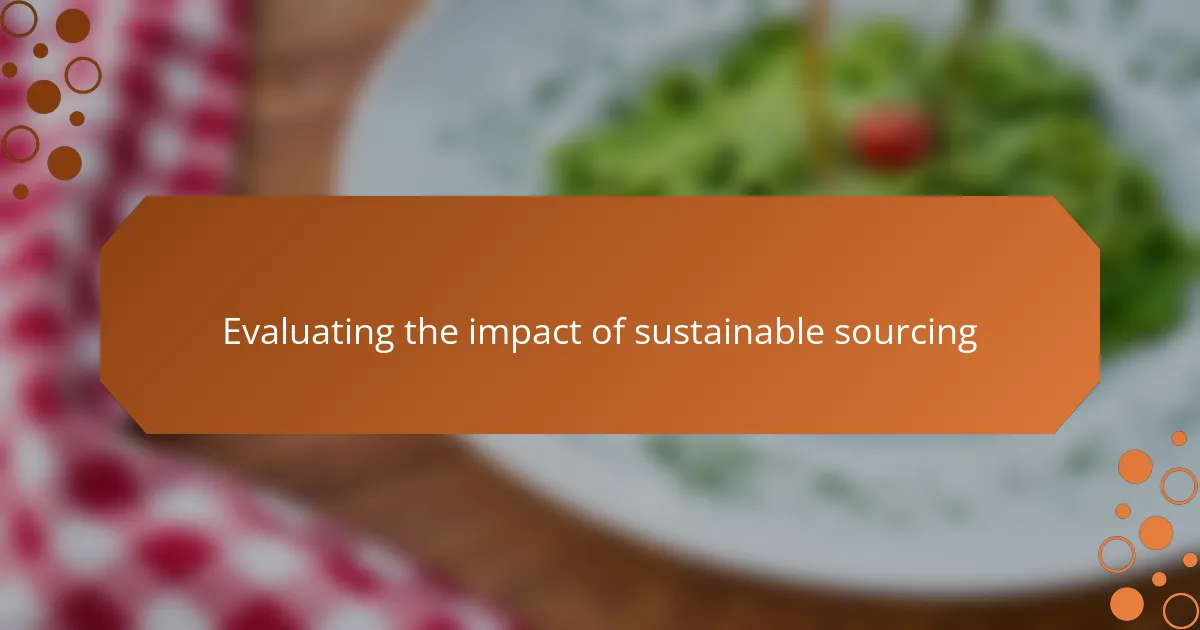
Evaluating the impact of sustainable sourcing
Evaluating sustainable sourcing goes beyond simply checking off a list of eco-friendly practices. From what I observed at Plume, its real impact lies in how these choices ripple through the ecosystem—supporting local economies, reducing waste, and preserving biodiversity. Have you considered how each ingredient’s journey affects not only the environment but the entire community around us?
I found it fascinating to see tangible results, like fresher flavors and a stronger connection to the place I’m dining in. It made sustainability feel less abstract and more personal, almost like a shared responsibility between the restaurant and its guests. Doesn’t that kind of mindful consumption make you appreciate your meal on a whole different level?
Reflecting on Plume’s efforts, I realized that measuring impact isn’t just about statistics—it’s about stories. The farmers they partner with, the careful selection of seafood, the seasonal menus—all these details show a commitment that resonates with me deeply. How often do we get the chance to be part of such a thoughtful cycle when we dine out?
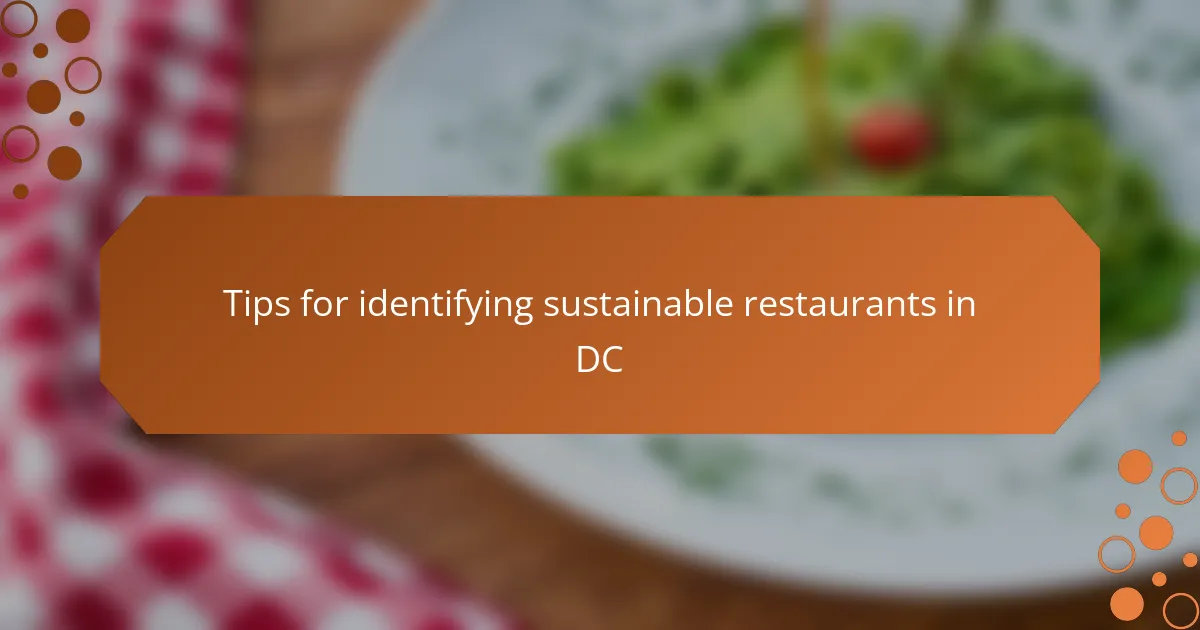
Tips for identifying sustainable restaurants in DC
One way I’ve learned to spot sustainable restaurants in DC is by looking for transparency on their menus or websites. When a place shares details about ingredient origins or highlights local farms, it tells me they care about where their food comes from. Have you ever felt more excited about a dish simply because you knew the story behind its ingredients?
I also pay attention to how restaurants handle seasonal menus. When the offerings change with the seasons, it shows they’re using fresh, locally available produce rather than relying on out-of-season imports. This practice not only supports sustainability but often means food tastes better—doesn’t a menu that evolves with nature sound more inviting?
Lastly, I’ve found that talking to the staff can be a great way to gauge a restaurant’s commitment. At places like Plume, the servers genuinely enjoy sharing where the food comes from and why it matters. Have you tried asking your server about their sourcing? Their enthusiasm usually reveals a lot about the restaurant’s values and how seriously they take sustainability.


